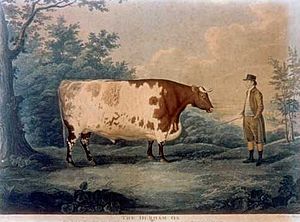Durham Ox facts for kids
The Durham Ox was a very famous steer (a male cow) from the early 1800s. He became well-known because of his huge size and perfect shape. This amazing animal helped set the standards for what we now call the Shorthorn breed of cattle.
Contents
Meet the Durham Ox: A Giant Steer
The Durham Ox was born in March 1796. He was raised by Charles Colling at Ketton Hall in County Durham, England. Charles and his brother Robert were pioneers in cattle breeding. They learned new ways to improve cattle breeds. One person they learned from was Robert Bakewell. He was very good at breeding Longhorn cattle.
Colling used Bakewell's ideas to make the Shorthorn breed even better. The Durham Ox was the grandson of Colling's first important bull, Hubbach. When he was first shown in Darlington in 1799, he was called the Ketton Ox. A painter named George Cuit even painted him in 1801 when he was five years old.
A Traveling Star: The Ox on Tour
In 1801, a man named John Day bought the ox for £250. This was a lot of money back then! John Day renamed him the Durham Ox. He even had a special carriage built for the ox. Four horses were needed to pull it.
For the next five years, the Durham Ox traveled all over England and Scotland. He was shown to people at agricultural fairs and other events. People loved seeing him. In 1802, when he was in London, people paid £97 in one day just to see him. That shows how popular he was!
Why Was the Durham Ox So Famous?
In 1802, an artist named John Boultbee painted the ox. The painting shared details about the ox's size. It said he weighed about 171 stone (which is about 1,086 kg). Some later guesses said he weighed as much as 270 stone (1,715 kg)! It's hard to be sure because the "stone" measurement wasn't always the same back then.
People admired the Durham Ox not just for his size. He was also seen as a perfect example of his type of cattle. At that time, farmers were starting to learn about "selective breeding." This means choosing animals with the best traits to have babies. The Durham Ox showed how successful this new way of farming could be.
The End of a Journey
In February 1807, the Durham Ox was on show in Oxford. He hurt his hip while getting out of his carriage. The injury did not get better. So, on April 15, 1807, he was slaughtered. After he died, his weight was reported to be 189 stone (about 1,200 kg). The Durham Ox remains a famous part of farming history.


